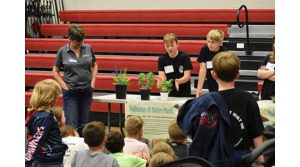4-H Youth Launch Projects to Improve Pollinator Habitat
$15K grant supports local efforts in eastern Kansas

Kansas teens are learning how to plan, plant and maintain habitats that attract butterflies, bees and other pollinators. (Photo courtesy of Cheri Nelsen, Wildcat Extension District)
MANHATTAN, Kan. – An ambitious group of teenagers have set out on a path to improve pollinator habitat in their communities, while giving a nod to the important role that bees and butterflies play in food production.
Cheri Nelsen, a 4-H youth development agent in K-State Research and Extension’s Wildcat District, said the teens are learning how to plan, plant and maintain habitats that attract pollinators.
“Many youth know about pollinators like bees and butterflies, but they don’t always know what is needed for attracting and keeping pollinators,” Nelsen said.
Earlier this year, Nelsen and Leavenworth County extension agent Sonya Murphy were awarded a $15,000 grant from the National 4-H Council and Corteva Agriscience to support community-based pollinator projects.
The group includes youth from the Wildcat District – which includes Crawford, Labette, Montgomery and Wilson counties in southeast Kansas – and Leavenworth County (northeast Kansas). Nelsen said 17 youth have received initial training for teaching others; each of those youth is charged with teaching an additional 250 youth about pollinator habitats.
National wildlife conservation officials have put recent emphasis on creating habitat that attracts pollinators. As an example, in mid-2022, the iconic monarch butterfly – known for its bright orange and black markings – was placed on the endangered list, a result of habitat destruction and climate change, among other reasons.
As they move about, pollinators often choose milkweed to lay eggs.
“Maintaining a healthy habitat is important for pollinators,” Nelsen said. In nature, bees, butterflies and other pollinators carry pollen from the male part of a flower (known as the stamen) to the female part of the same or another flower.
Nelsen adds: “We all need to eat, and pollinators also play a vital role in food production (by pollinating food crops). For myself, I enjoy watching kids learn new things and doing things to help the community.”
In Parsons, youth are planting a seven acre plot to native plants. Nelsen said part of the process is determining what type of pollinator plants need to be included.
In Leavenworth County, youth are planning a pollinator garden at the Veteran’s Administration hospital.
Nelsen said youth have also taught lessons at Earth Day and in local schools, and are planning events during the upcoming county fair season.
We are here to share current happenings in the bee industry. Bee Culture gathers and shares articles published by outside sources. For more information about this specific article, please visit the original publish source: 4-H Youth Launch Projects to Improve Pollinator Habitat | Morning Ag Clips








